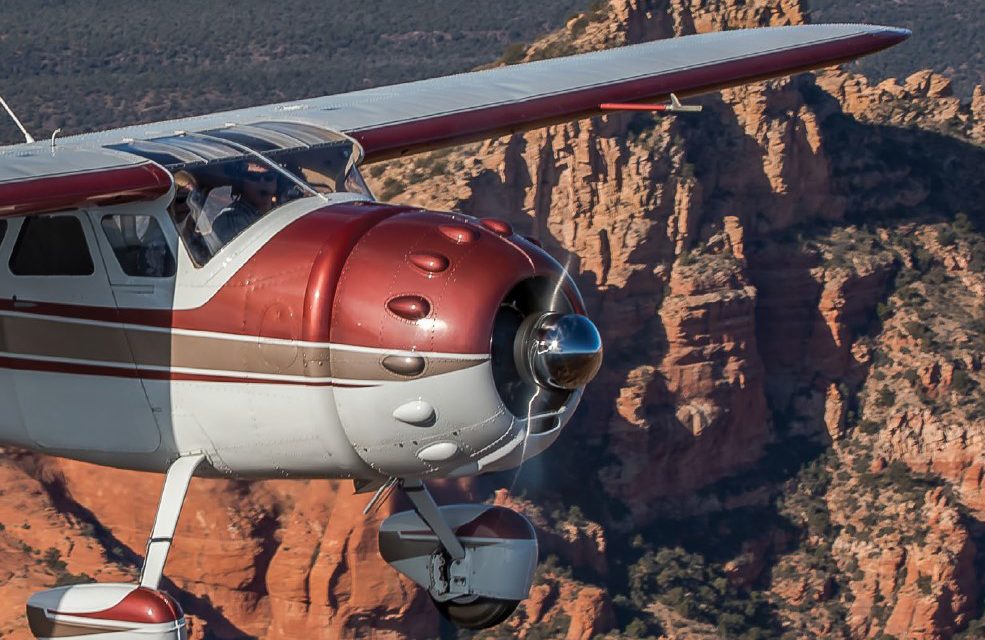Single with Class
When America finally entered World War II in December 1941, it was ill-prepared for conflict, especially on battlefronts on opposite sides of the world’s largest oceans. America’s air force was nonexistent at the time — mostly a hodge-podge of outdated airplanes and relatively untrained pilots.
While there was some general aviation activity, it was mostly confined to barnstormers, air show performers, and a small group of rich businessmen.
Four years later when the war ended and thousands of pilots came home, the situation was reversed. While many aviators were horrified at memories of air combat, others hoped they could continue flying in single- and twin-engine private aircraft. Some former fighter pilots even envisioned flying in demilitarized versions of the airplanes they flew in Europe or Japan.
Though it was possible to buy a war surplus (or even a brand new) P-51 Mustang, still packed in cosmoline and in its original shipping crate, for only $2,500 — remember this was 1947 and that represented a small fortune in 1947 dollars (adjusted for inflation that would be just over $30,000 today). These days, a barely flyable Mustang would probably set you back well over $1 million.
The government produced some 300,000 aircraft for the war effort, most of which had to be scrapped as there was little civilian application for them. Foreign governments were eager bidders, but few civilians could afford to buy their own fighter planes. I witnessed an unusual job for a Mustang when I was fighting forest fires in Alaska in the 1960s. A pilot based in Fairbanks had a solid pink Mustang (named, inevitably, Pink Lady) that the bureau of land management often chartered to reconnoiter several fires at a time above the Arctic Circle. With underwing external fuel tanks full, the Mustang had the range to check in with fire bosses at a half-dozen fires all over the state. I heard he eventually rolled the airplane into a ball trying to land at a rough dirt strip in southeast Alaska.
I know of one Texas entrepreneur, Al Alson, who bought several dozen, surplus and new, unassembled warbirds and turned his small fortune into a large one by selling them off one at a time as they appreciated exponentially. Al stored the fleet in a large hangar in Marana, Arizona, one of the driest climates in the U.S., which was more than coincidentally located only a few miles from Davis-Monthan Air Force Base outside Tucson where old, outdated, or retired warbirds go to die. Al was able to buy his own general aviation company, Lake Aircraft, with the proceeds.
War surplus aircraft may have looked attractive based on purchase price, but operating costs were well out of reach of the average retiring military fighter pilot, lieutenant, or captain returning from the war.
The aforementioned P-51 burned about a gallon a minute in normal cruise and three times that during high-power maneuvering. Even if you could somehow afford the fuel, parts and maintenance would demand a nearly full-time mechanic and the resources of a small South American country.
Of course, the established general aviation manufacturers and dozens of upstart companies jumped into the light-plane business with enthusiasm, and many of the latter companies went bankrupt in a few years.
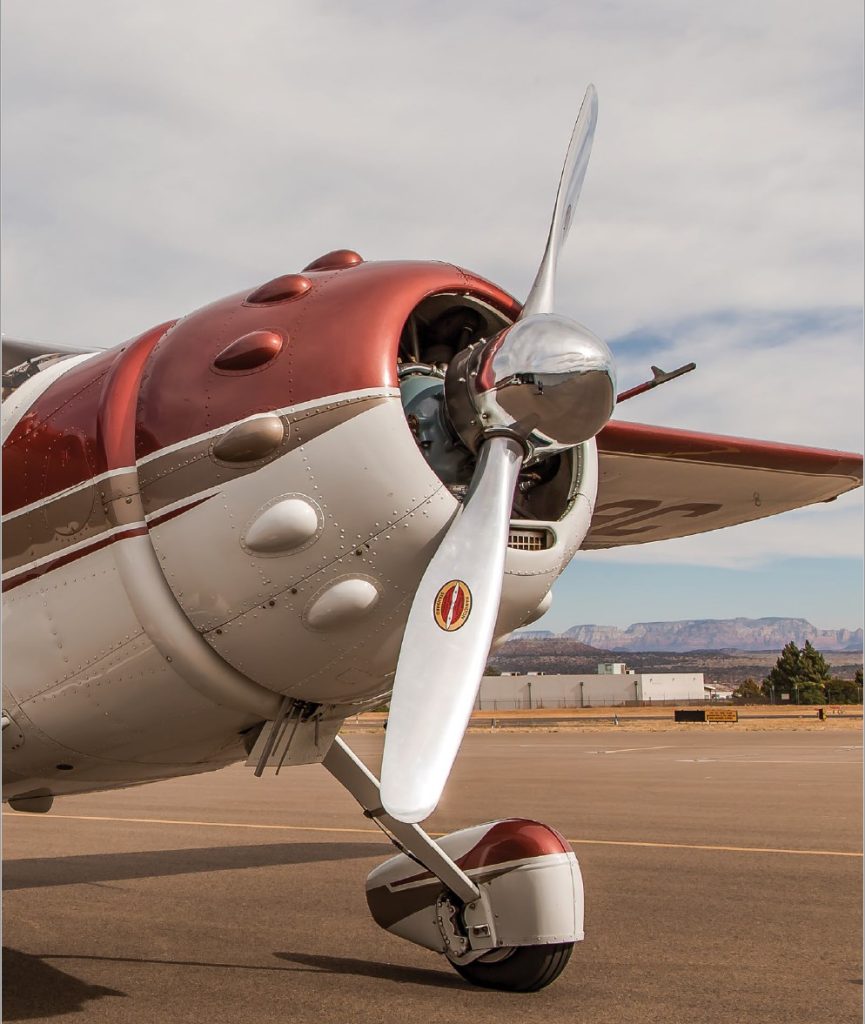
For its part, Cessna introduced a new model known as the 190/195. The new airplane was probably a much better machine than its sales record suggested.
The Cessna 190 utilized a Continental W-670-23 radial engine putting out 240 hp, and the more upscale model 195 was essentially the same airplane fitted with a Jacobs R-755-5 mill (sometimes derisively referred to as the “Shaky Jake”), eventually upgraded from an initial 245 hp to 300 hp.
Public reception turned out to be lukewarm at best, nothing like the postwar dream. The Cessna 190 went out the door at about $15,000, and the 195 was tagged at more like $16,000. In 1954 when production was discontinued, both airplanes had list prices above $20,000.
The model was an all-metal class act, and many were left in polished aluminum finish. The 190/195 manifests that indefinable quality known as “class,” a quality more often associated with a Spartan Executive or a Beech Staggerwing. For many pilots, it’s the same reaction with the Cessna 190/195.
Though the 190/195 was born in the post-WWII rush to accommodate an aviation market that never materialized, the Cessna 190 and 195 were designed to one-up the Beech Bonanza. The goal wasn’t to outrun the jaunty Beech 35, but to provide ultimate Packard-style interior comfort to a class of aviators who believed the race wasn’t always to the swift.
While there’s no evidence that Cessna designer Dwayne Wallace configured the 190/195 Businessliner around a Packard interior (as the Klapmeier brothers built their Cirrus around the BMW 5-series furnishings), the new Cessna airplane’s mission was considerably more refined than the Bonanza’s, more concerned with how comfortably you arrived than how quickly you traveled.
The 195 was essentially an Airmaster with a hormone injection. The notably smaller 1930s-era C-37 Airmaster flew with only 165 hp to protect it and carried four people (it says here) in modestly cramped comfort at speeds of 120-125 knots.
The Cessna 190/195 was the same airplane except scaled up in every department, a good thing because Cessna introduced the airplane in 1947 at a base price of $12,750, about $3,000 more than a similar vintage Bonanza. The Cessna 195’s 300-hp Jacobs engine boosted its price an additional $1,000. That was a pile of money in those days, but it bought a semi-cabin class airplane that was closer to a Spartan Executive than anything else.
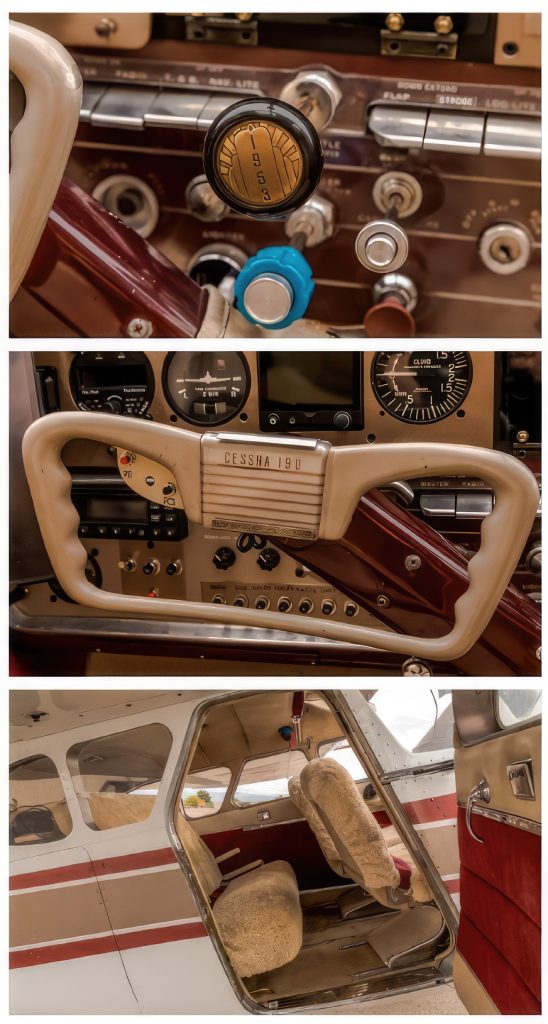
In exchange for such a stipend, Cessna delivered a product that was definitely a cut above the late-1940s competition. With a huge, 755-cubic-inch, seven-cylinder Jacobs radial mounted on the nose, the 195 transferred most of the engine’s 48-inch width to the cabin. The 195 was the last American airplane ever certified with a radial engine, and it carried off the job with style.
Even today, 190/195s always attract a crowd on any ramp. Pilot and passengers enter through a left-side aft door, then walk forward to the front office. Seating is for five in a two/three configuration, though a four-place maximum is more common.
Pilot and co-pilot climb forward to front seats perched behind a gigantic panel and a windshield that drapes well back over the cockpit.
The airplane sports a multitude of features not found on most other airplanes of the time. Outside the 195, the big, 218-square-foot wing is full cantilever with no struts or braces to add drag. The Jacobs engine is hinged at the side, to provide convenient service access to mag, distributor, starter, and generator, as well as the rear of the engine itself. The engine is so tightly cowled that the rocker arms hide under small bumps around the cowling.
The gear is Steve Wittman’s patented design, constructed of chrome-vanadium steel for strength. The baggage compartment is accessed through a flush push button rather than a conventional handle. Landing lights are electrically activated and arc down out of the wings, a system later adapted to the Cessna 421.
Inside the 195’s cockpit, there’s a roll-down storm window fitted with plate glass, rather than Plexiglas, on the pilot’s side. Front seats adjust fore and aft through a surprising 14 inches to accommodate even the longest legs. A quartet of windows stretched along each side of the airplane provide plenty of light despite the high wing. The parking brake has the added benefit of locking the controls as well as the main wheels. The main cabin door also does double duty: It’s directly connected to the boarding step and automatically retracts when the door is closed.
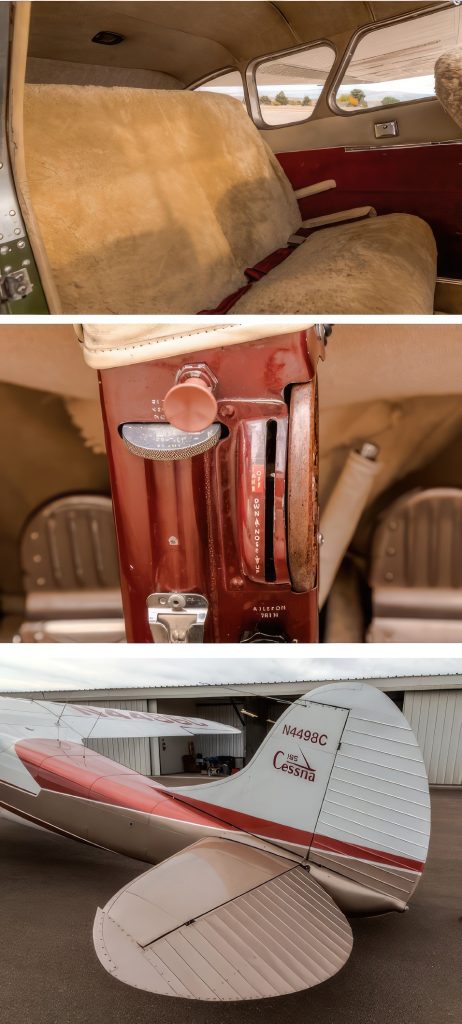
The 195 is more of a Bentley than a Jaguar XKE, and that was exactly what Rick Farrow of Godfrey, Illinois, was looking for. Rick, a Snap-On Tools sales manager, had worked his way through a half-dozen airplanes, culminating in a Beech Baron E55. More than 20 years ago, however, he amazed his friends by trading the fast, twin-engine Baron for the Cessna 195.
“I think everyone was stunned,” Rick said. “The E55 is almost universally regarded as a 200-knot hot rod, and no one ever expected me to trade for a classic Cessna 190 or 195.”
In fact, Rick’s airplane started life as a 190 with a Continental radial but was later upgraded to a 300-hp Jacobs to make it a 195.
Rick, however, didn’t regret the transition from hot twin to classic single. “The 195 certainly isn’t one of a kind, but it’s one of a few,” he explained. “There were just over 1,000 of the type built, and probably half of those are still flying (some of them overseas) but no matter where I go (except to air shows like SUN ’n FUN or Oshkosh), I almost never see any other 195s on the ramp. It’s a very unusual airplane.”
Rick flew his big Cessna regularly all over the Midwest. Just as with his Baron, he used the airplane for corporate travel in pursuit of business for Snap-On Tools. “The company has a toolbox plant in Algona, Iowa, 50 miles from Mason City, and there’s no convenient airline service,” he said. “With the 195, I fly out of my local airport near St. Louis and into the small, general aviation Algona Municipal Airport, do business, and I’m home for dinner.”
Rick also made the occasional weekend hamburger flight and regular vacation trips to the Bahamas. He’s an enthusiastic air show fan, and that’s where we caught up with him: at EAA AirVenture Oshkosh a few years ago.
We jumped at the chance to fly Rick’s near-perfect 195. The engine start is a little different from firing up a standard Continental or Lycoming. After all the usual preliminaries, you engage the starter, then flip the mag switch to “Both” after six blades have rotated past. In typical radial style, the cylinders cough and sputter, voting on whether conditions are right to run, then gradually come online until the “Shaky Jake” has all seven cylinders firing.
Actually, the Jacobs’ nickname seems inappropriate for the 195’s R755. This engine is generally remarkably smooth, turning only 2200 rpm at redline.
“Leaky Jake” might be a more appropriate moniker. It seems all radials leak oil, so much so that the Jacobs R755 features a huge, 5-gallon (yes, that’s 20 quarts), dry sump oil tank mounted just behind the instrument panel. (One peripheral benefit of this arrangement is that in frigid weather, you have 5 gallons of warm oil circulating through the forward fuselage to help reduce the chill.)
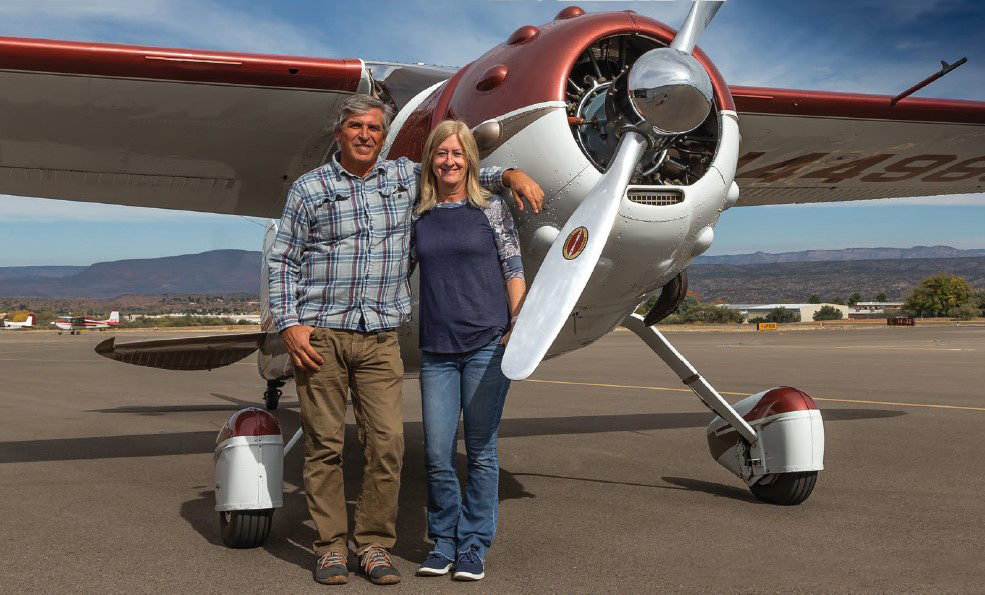
Just as with turbines, insufficient battery power can result in a piston version of a “hot” start. If the engine backfires during start, not uncommon with Jacobs radials, you can wind up with an induction fire.
Standard procedure is to continue cranking to suck the flames back into the engine. If your battery is low on volts and can’t continue to turn the starter, you could be in a bad situation.
Taxiing to the runway is a little different in a 195, because the airplane is effectively blind on the right. Scrunch your head against the left sidewall and you have a semblance of visibility straight ahead, but S-turns are still mandatory because of the high deck angle. The panel is so wide, you’d have to make radical left S-turns to see anything forward on the right. Some pilots prefer to make severe left turns to open up the view straight ahead.
You have the same problem on takeoff, but the tail comes up fairly quickly, so you can see what you’re about to hit. The big wing levitates like an elevator rather than pitching up precipitously, and the airplane clears the ground at 1,000 fpm at Vy. Again, though, forward visibility is severely limited at such a pitch attitude, and most pilots, Rick included, prefer to ascend at a cruise climb of 95 to 100 knots, usually worth 750 fpm.
You sit high in the 190/195, about even with the wing, so maintaining visibility is easier by simply leaning forward ahead of the wing and looking out the side of the windshield.
I discovered this problem during the formation session. It’s a relatively easy bird to hold in position, but you do need to avoid losing the photo ship above or below the wing.
Rick suggests that block cruise is about 135 knots, and if that’s at least 60 knots slower than his old Baron, he doesn’t mind a bit. “I can fly for as long as four hours if I need to,” he said. “That’s nearly 550 nm in the 195, and I enjoy flying the airplane so much, I hardly notice.”

Perhaps the Cessna 195’s strongest suit is comfort and stability. It plows through turbulence with minimum fuss. “My wife, Jeanie, is a pretty informed passenger, having ridden in several of my other airplanes,” Rick said. “She offers a passenger perspective I might not enjoy, because I’m so wrapped up in considerations of performance, handling, and other flying characteristics. She often flew with me in the E55 and other airplanes, and she says there’s no question this Cessna 195 offers the best ride of any machine she’s been in.”
Descents in any radial present a challenge in that it’s important to maintain reasonable oil temperatures. The 195 is especially susceptible. The big wing resists descents, seducing you into major power reductions. Chop and drop letdowns, however, are out of the question in a 190 or 195. You need to plan well ahead to make certain you don’t induce shock cooling and reduce oil temps to dangerous levels.
Precise Flight speed brakes would be a welcome addition coming downhill but, unfortunately, they’re not approved on the 195. The only alternative is careful planning and some flaps.
With a dirty stall speed down around 55 knots, approaches work out best at 70 knots or more. The small, short-chord flaps are relatively ineffective except at lowering the nose during approach. Landings aren’t nearly the challenge you may expect, but you do need to stay off your toes while returning to earth.
The trick is to stay away from the brakes unless you’re about to lose it completely. Cessna 195s aren’t that tough to land unless there’s a bad crosswind or you’re doing something dumb. I’ve done my share of dumb things in 195s, but (knock on aluminum) I haven’t lost one (yet).
Cessna’s last round-engine airplane serves all over the world, and you’ll often see the type in Alaska and Canada operating on wheels and skis as well as oversized tires. No one will mistake it for a STOL machine, but it hauls a good load and can land in places that many other airplanes can’t.
If you ask Rick, he believes he’s found the perfect airplane. “I love the 195. About the only thing I’d rather have would be a later version, perhaps one of the last 1954 models.
“There’s probably no such thing as an end-all, do-all airplane,” Rick said. “And despite all its talents, the 195 certainly wouldn’t qualify in every application. For me, though, it offers a little nostalgia, reasonable performance, great comfort, and that indefinable quality known as class.”


